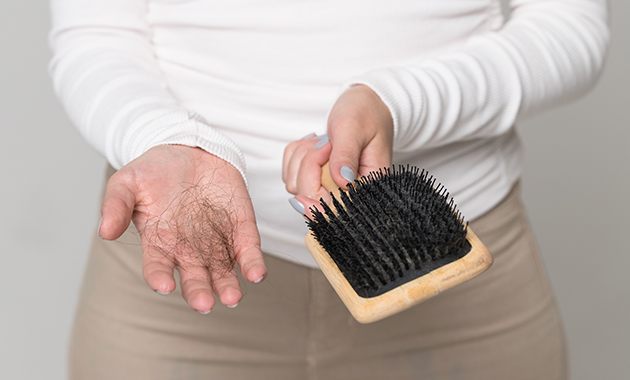
Hair fall is a widespread problem. It is normal to shed around 50-100 hair strands every day.[1] But stress, aging, illnesses, family history, styling, medicines, hormonal imbalance, etc. can make you lose more hair. Many people are complaining about hair fall in the post-COVID phase. In this article, we elaborate on hair fall after COVID infection and try to understand why it happens.
Explore healthy ways to manage your hair fall in our wide hair care range.
Basics First: Lifecycle of hair
Growing or anagen phase: About 2-8 years long, 85-90% of the hair on your scalp is in this actively growing phase.
Transition or catagen phase: Lasts for 2-3 weeks, in this phase hair follicles shrink. Up to 5% of your hair is in this phase.
Shedding or telogen phase: This is a 2-4 months long resting phase at the end of which the hair falls.
When a hair falls out, new hair grows in the same hair follicle. The growing cycle is repeated, starting again at the growing (anagen) phase.
Hair fall after COVID recovery: Is it a side effect?
Illnesses, stress, and shocking incidents can cause noticeable hair loss. Such hair fall has also been seen in people recovering from COVID-19. Technically, it is not hair loss but hair shedding and is called telogen effluvium.
It is a temporary condition in which an increased proportion of hair enters the shedding phase due to shock or stress. As a result, mass shedding of hair occurs.
Note:
The hair fall usually starts 2-3 months after the infection because when the illness starts, the telogen phase sets in and remains for 2-3 months. When the phase ends, hair fall is noticeable.
Shock to the system can lead to the shedding of over 70% of scalp hair.[2]
Seek the help of an expert dermatologist to fix your hair loss issues soon.
Why does it happen?
The exact reason why illnesses trigger hair fall is not known. However, it may be possible that illnesses like fever and COVID-19 suppress the production of new cells and proteins in the hair follicle. As a result, hair may fall out and even the growth of nails may seem affected.
5 Tips to manage post-COVID hair loss
1. Correct your nutritional deficiencies: Taking enough vitamin D and iron can help improve telogen effluvium or hair fall after COVID. It has been seen that low iron levels can reduce hair growth. So, take abundant amounts of protein, fresh fruits and vegetables. Bask in the sun for around 10-30 mins* between 11 a.m. to 2 p.m. to restore your vitamin D levels.
Browse our range of multivitamins to maintain optimum levels of nutrients in your body.
2. Be patient: Mostly, hair shedding gradually decreases within 6-12 months post-recovery. It may be distressing to see a handful of hair every time you comb your hair. You may lose 300 hairs instead of 100. But remember, hair fall after COVID is temporary, and stressing over this can further worsen the hair shedding.
De-stress the ayurvedic way with our range of mind care products.
3. Know when to consult an expert: You must reach out to an expert if you notice redness, rash, itchy scalp, or burning in your scalp along with hair loss. It could be due to something other than telogen effluvium triggered by COVID. Hair fall caused after COVID-19 infection is a temporary and self-limiting condition. However, if you think it has become chronic, do not hesitate to speak to an expert.
4. Supplements may help: Biotin supplements may help improve the hair fall after COVID by helping in hair growth and improving inflammation. Other than this, minoxidil 5%, an FDA-approved medicine, may also foster hair growth for chronic telogen effluvium. Avoid using minoxidil if you are pregnant or breastfeeding.
Speak to an expert before taking any supplement.
5. Use hair care products wisely: Wash your hair to keep it free of dust and pollution. Make sure to wash off all the shampoo from your hair to prevent any scalp buildup. Avoid applying any hair product vigorously as that may cause hair fall. Oiling can help protect the hair cuticles, but avoid using excess hair oil as that may have less to no impact.
Though shampoos may not have a direct effect on post-COVID hair loss, washing your hair with a mild, sulfate-free shampoo may help.
Look through our shampoos and conditioners range of products right away.
(The article is reviewed by Dr. Swati Mishra, Medical Editor)
References:
1. Hair Loss in Women: Causes, Treatment & Prevention. Cleveland Clinic. https://my.clevelandclinic.org/health/diseases/16921-hair-loss-in-women
2. Telogen Effluvium Hair Loss. American Osteopathic College of Dermatology. https://www.aocd.org/page/telogeneffluviumha#:~:text=A%20telogen%20effluvium%20is%20when,months%20after%20the%20%22shock%22
* Duration of sun exposure depends on factors like skin tone and weather. While people with darker skin tone need longer sun exposure, people with lighter skin tone need comparatively lesser time in the sun.